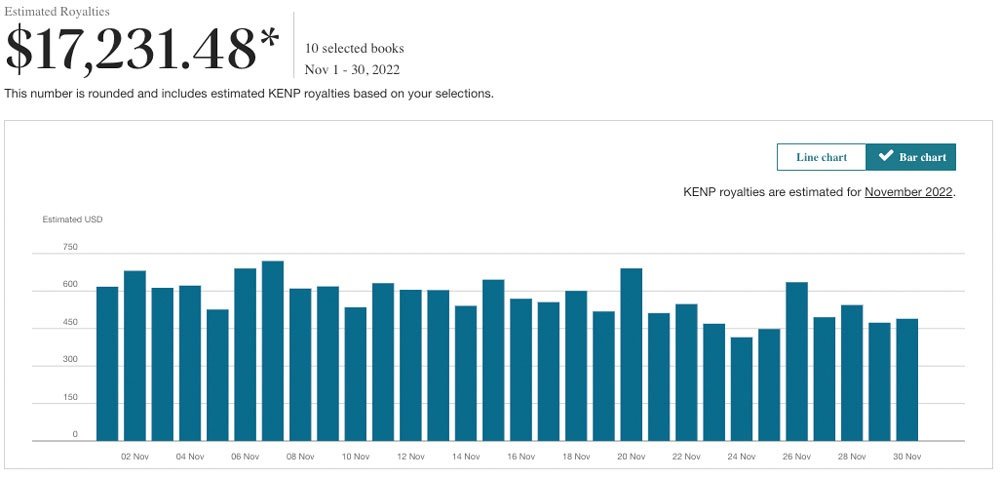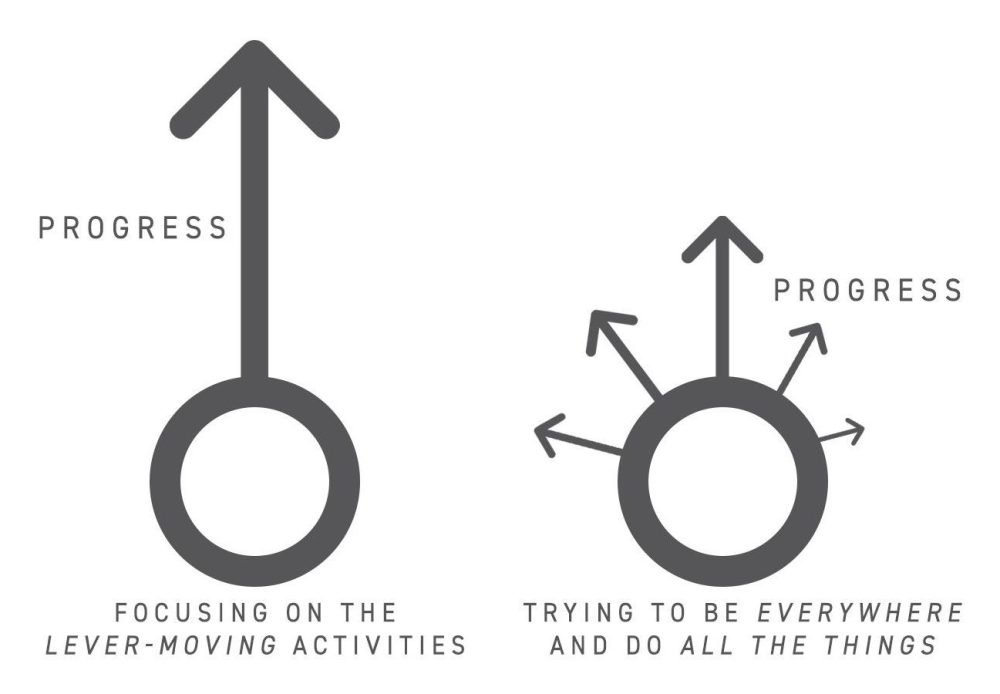
Today’s post is by book advertising consultant Matt Holmes (@MatthewJHolmes1).
When I first started marketing my wife’s books, I thought we needed to be everywhere and do all the things in order to be successful:
- Facebook ads
- Amazon ads
- BookBub ads
- YouTube ads
- Promo sites
- Facebook groups
- All other social media platforms
- Newspapers and magazines
The list goes on—and on. The truth of the matter though, is that you don’t need to do even half of what’s on that list.
The do all the things approach likely does more harm than good, especially in the beginning. Sure, further down the line, you can start adding to the list, but even then, don’t feel you need to.
My wife’s books currently earn a healthy six-figure income. And we use two traffic sources:
- Facebook ads
- Amazon ads
Now three years into the journey, we are starting to explore other traffic sources so as not to rely so heavily on Facebook and Amazon. But these two platforms alone, along with a small spend on BookBub and promotional sites for launches and promotions, drive the results for us.

In this article, I’d like to share with you how I spend 30–60 minutes each day marketing my wife’s books, and how you can do the same.

Marketing for 30–60 minutes per day came about as more of a necessity than anything else; with three children under the age of three in the house, time isn’t something either my wife or I have much of! If you currently have young children or have done so in the past, you’ll know where I’m coming from. So I had to make sure every minute I spent was on the right marketing for us.
Avoiding the shiny objects discussed in Facebook groups, i.e. the latest fads, I identified what was driving results for us and doubled down on them, eliminating everything else.
This is when I (accidentally) identified what I now call the four pillars of book marketing. And, after speaking with many authors over the past couple of years, I believe these four pillars are critical for every author.
Without them, you’ll be spinning your wheels not knowing what to work on and when, or worse, spending your resources on things that don’t move the needle.
So, here’s what you’re going to learn:
- What the four pillars of book marketing are
- Why 30–60 minutes per day spent marketing is all you need
- How and why to craft a strategy for your author business
- Identifying your lever-moving activities
- How to plan out your days, weeks, and months for maximum productivity and results
The 4 Pillars of Book Marketing
Some activities in your author business may not be exciting but are essential to keep your business going, such as accounting, taxes, replying to emails, and other admin/auxiliary tasks.
When it comes to marketing and driving book sales, there are really only four pillars that truly matter:
- Book product page
- Traffic
- Audience building
- Profit
Book product page
Something I say to authors a lot is: Your book sells your book.
No amount of marketing or advertising is going to sell a poor-quality book.
You could be the best marketer in the world, but if your book itself isn’t up to scratch, isn’t up to the standard it needs to be in today’s world of publishing, it’s not going to sell.
You may be lucky and get a few sales, maybe even a few hundred sales right off the bat. But when the reviews and ratings start coming in, the performance of your marketing is going to decline over time.
This is why, yes, you need to write a stellar book. But you also need to present your book in the best possible light. And you achieve that by creating a superb book product page.
After all, sales don’t happen in your Facebook ads, BookBub ads, Amazon ads, etc. They happen on your book product page. That’s where readers make the decision to buy or not to buy your book.
The key assets of your book product page you need to focus on are:
- Book cover
- Book description
- Pricing
- Reviews and ratings
- Look Inside
- A+ Content, specific to Amazon (optional)
With a compelling and engaging book product page in place, all of your marketing and advertising will perform that much better because your conversions (i.e., sales directly from your ads) will be higher.
And the more sales your ads generate, the more organic sales (sales that come as a result of your Amazon rank) you’ll enjoy.
Traffic
Without eyeballs on your books, you will not sell books. Period. Thus, to make sales every day, you need readers to see your books every day. And that is achieved by driving traffic to your book product page. Can you see how these four pillars are starting to connect?
Now, there are many forms of traffic generation, including, but by no means limited to advertising, newsletter swaps, group promotions, and promotional sites. But you don’t need to do all of them. When you’re just starting out, pick one or two platforms and really get those dialed in before you start adding more to your plate.
For my wife’s books, we are exclusive to Amazon. Authors who have books in the Top 500 of the Kindle store generate 80–90% of their sales directly as a result of their bestseller rank. These are all, essentially, free sales.
But to achieve a great bestseller rank and enjoy those organic sales, you need to tickle the Amazon algorithm enough to take notice of you, which you do by driving sales through your own marketing and advertising efforts, such as Facebook ads and Amazon ads.
Audience building
As an author, your biggest asset is your books. Your next biggest asset is your audience.
I’m not talking about your Twitter followers or Facebook likes. I’m talking about true fans of your books, who you have direct access to through email.
The issue I have with building an audience on platforms such as Twitter and Facebook is that you’re building this audience on rented ground. If your account on one or more of these platforms is suddenly shut down, you would lose your entire audience overnight.
To avoid this situation, by all means, build an audience on these platforms, but, make sure you are de-platforming people by encouraging them to join your email list, which is best achieved through offering them something in return for their email address, such as a short story, a novella, a bonus chapter, or even a full book; this is commonly known as a reader magnet.
With an email list, you can contact your audience at any time (within reason, of course), ask them to buy your new release, leave a review of your book, and let them know about a flash sale you’re running.
When your email list becomes large enough, you can drive a LOT of sales of your new releases and your backlist, and it won’t cost you a penny in advertising. Your world really is your oyster when you have an email list.
Just respect your audience, don’t spam them, provide value (yes, even entertainment is considered value), and share a little or a lot, whatever you’re comfortable with, about yourself, your writing—even Tibbles, your cat, who accompanies you whilst you write!
Remember, you are communicating with real people, so be sure to treat them as such. And ultimately, be your true authentic self.
Profit
Ultimately, if you want to become or remain a full-time author, you need to make a profit (unless you have very deep pockets and don’t need the money).
Royalties are more bragging rights than anything else. The number that really matters is profit, or the money you take home in your pocket after paying for ads, promotions, etc.
The best way to keep an eye on your profit and other financials is to track your numbers. At a minimum, I would recommend tracking the following:
- Royalties earned
- Total ad or marketing spend (you could break this down into ad spend for each platform)
- Total orders
- Total page reads if you’re in Kindle Unlimited
- Email subscribers
- Profit
This fourth pillar is perhaps the most important because, without profit, you will not be able to continue writing full time (again, unless you have no financial worries).
In your 30–60 minutes of intentional marketing sessions, your task(s) should be focused on one of these pillars.
Why 30–60 minutes per day spent marketing is all you need
In the beginning, I would spend four to six hours per day marketing Lori’s books. Granted, I learned a lot. But at the same time, I was tinkering with things too much, whilst also splitting my time, energy, and limited budget far too thin.
Since then, three children later, I now work on the marketing of my wife’s books for an average of 60 minutes per day; sometimes more, sometimes less, depending on what is happening at the time. If we have a book launch or promotion coming up, I’ll typically spend a little longer than 60 minutes per day, just to make sure everything is in place.
But in a typical week, 60 minutes per day is about average.
And you know what? Since cutting down my time to just 60 minutes per day, results have been better than ever.
In 1955, British author and historian, Cyril Northcote Parkinson, wrote in an article for The Economist that “work expands to fill the time allotted for its completion.”
This became known as Parkinson’s Law.
If you give yourself four hours to set up your Facebook ads, it will take four hours. If you give yourself 60 minutes, you’ll have it completed in 60 minutes.
When I’m in a 60-minute marketing session, here’s what I do:
- Step 0: The night before, I plan out exactly what needs to be done in those 60 minutes.
- Step 1: I sit (or stand) at my desk knowing what I need to work on.
- Step 2: Put on a pair of noise-canceling headphones and listen to Brain.fm (music that has been composed to help you focus), put my phone in another room, and turn off all notifications on my computer (yes, that includes email!)
- Step 3: Work the plan! I work on exactly what I planned out the night before, nothing more, nothing less.
- Step 4: Review my work and reflect on what I’ve done.
- Step 5 (bonus): Reflect at the end of each week, and ask myself questions to help me improve for the following week.
So how do I know what I need to work on? That’s where strategy comes into play.
How and why to craft a strategy for your author business
Without a strategy, without direction, without knowing where you’re heading and why, you’re drifting. It’s like getting into your car and driving with no destination in mind.
Here’s how I define strategy: A strategy is set of choices or actions you make that positions your books (and your author brand as a whole) on the playing field of your choice (such as Amazon) in a way that you win.
Your strategy will set the intention for every single marketing activity you do. It will help you keep everything on track. It will help you identify what is and isn’t worth your time. What you should say yes to, what you should say no to.
The mistake many authors make is that they have a huge long list of tactics (the individual actions or activities you perform), but no strategy to tie them all together.
The result of this is that marketing becomes overwhelming because they have so much they think they need to do, and end up doing nothing because they have no idea where to start. This is sometimes referred to as paralysis by analysis.
And that’s why you need to identify which tactics truly move the lever for you.
Identifying your lever-moving marketing activities
There are countless opportunities out there for authors to market their books, and I completely understand just how tempting it can be to do it all. If you follow that path though, I can promise that you will burn yourself out and become a slave to your business. Ask me how I know!

The better, more sustainable option then, is to identify your lever-moving activities and double down on them. Don’t fret about what other authors are doing and think you need to do that too.
I’m not saying to never test new ideas; just allocate additional time to do so. The 30–60 minutes you spend each day marketing should be 100% dedicated to the lever-moving activities.
The best way I’ve found for identifying lever-moving activities is to write down every single marketing-related task you perform over the course of a week. Then look at that list and identify the 20% of tasks (because that’s all it will be) that are driving 80% of your results. These tasks will fall into one of the four pillars:
- Book product page
- Traffic
- Audience building
- Profit
How to plan out your days, weeks, and months
Planning may not be the most exciting thing to do (though, admittedly, I rather enjoy the process of planning!), but by taking the time to:
- Plan out your goals for the weeks and months ahead
- Know what you want to achieve and by when
… you’re going to achieve so much more than you would with zero planning, or winging it.
The time you spend marketing will be 100x more effective than you thought possible because you’ll get more done in just 30–60 minutes than you otherwise would in an 8-hour day.
Without a plan, you’ll have 37 different things floating around your head, not knowing which one to work on today. Before you know it, you’ve replied to a few emails, doom-scrolled on your favorite social media platforms, refreshed your KDP dashboard 10 times, and 60 minutes later, you’ve achieved nothing meaningful. I’ve been there. Trust me.
Parting thoughts
I hope I’ve convinced you of the importance of planning your time effectively, and given you permission that it’s OK to not to be doing all the things.
Now, if you want to be everywhere and do all the things, go ahead. Just be very aware that if you’re saying yes to something, you’re saying no to something else. And that something else could very well be one or more of your lever-moving activities. And remember, you don’t need to do more. Try doing less, but doing it better. That’s only possible when you remove all the dead weight from your days, weeks and months, and focus your time, energy, and budget on the 20% of activities that are driving 80% of your results.
Matt Holmes helps self-published authors build a thriving, sustainable, and profitable six-figure business, using Facebook Ads as the driving force for reaching new readers every single day. He writes a free newsletter read by thousands of authors, called The Saturday Self-Published Author, helping authors run profitable, scaleable Facebook Ads and sharing lessons from building and growing his wife’s six-figure author business.
You can learn more and sign up for FREE here – When you sign up, you’ll also receive a FREE 3-day video course – The Facebook Ads For Authors Masterclass.
He lives in the UK with his author wife, Lori, their boys, Jacob, Caleb, and Jonathan, and their dogs, Freya and Loki. Learn more at his website or follow him on Threads.

First, congratulations on your success. Your wife is lucky she’s got an in-house publicist so she can concentrate on writing books. I don’t indie publish but I do think you can be more successful in that arena if you (1) pick a genre that is typically sold through e-books and in quantity, such as science fiction, romance, etc. and (2) write a series so there is cross-pollination between books and also so you can offer a perma-free one as part of your promotional package. For those of us writing stand-alones in more “literary” categories, it’s a much tougher path.
Thank you so much, Maggie. Yes, we make a good team 🙂 She’d like to do more of the marketing and business side of things at some point, but for the moment, she’s enjoying putting her full energy into writing the books.
I agree, eBooks, and especially Kindle Unlimited, selling in volume, has worked very well for us. As has a series, with a strong readthrough.
Permafree books though, unfortunately, aren’t as powerful as they once were. Yes, they can move a lot of free downloads, but the readthrough from them nowadays is close to zero, so a better option we’ve found is pricing books no lower than $0.99 / £0.99.
Yes, marketing standalone books profitably is definitely more of a challenge.
Exactly, Maggie! What works for indie authors of genre series largely doesn’t apply to literary stand-alones or non-series nonfiction. Especially when there’s no in-house publicist in the dining room. (And now back to writing new books while fretting about publicity for the existing trad three…)
Thank you for this information and the clear, concise way you have presented it. While I know self-publishers don’t need to “do it all” as far as marketing options go, I had no idea what would be “enough,” what might work. This gives me a place to start. I really appreciate this article.
Thank you for your kind words, Kim, that is great to hear that you now have a starting point for what is enough. Less is definitely more when it comes to marketing.
What a superb success story! Congratulations to you and your wife on her writing stellar books and you marketing them so well. This one post contains what I’d learn in a whole marketing webinar! Thank you for this.
Thank you so much, Katherine; your words truly mean a lot to me and I’m thrilled to hear that you learned so much from the article.
Matt, Thank you for sharing this guide. Your wife is very fortunate to have you in her corner. I am sure this is well beyond the bounds of what you can advise on, but I thought I’d comment just in case.
Everything you’ve written about having all the “tactics” but no strategy resulting in doing a LOT of things with little effect vs a few things better…this is the story of my life. For me, thinking I need to do all of it doesn’t result in inaction, but rather I’m ALWAYS working on countless “tasks” but can never find my “strategy.”
I’m speaking to my work overall (I am a one-person educational nonprofit, writing, filming, editing, animating educational videos with articles, ecourses, etc…keeping up social media presence, doing all the SEO research, all the accounting—everything!)
AND…I want to actually write books (with what time??) That’s what brought me to this article. My compounding issue is that I am Autistic. While I understand logically what you (and so many) say about getting a strategy and figuring out what are the most important things….that’s the one thing my brain cannot seem to do.
I’ve tried everything, and I don’t have a partner to help. I’ve tried all kinds of prioritization approaches, analytics, etc. The way my brain is wired, I cannot get perspective, so I stay lost in the “tactics”/tasks…never being able to gain a greater perspective.
Again, I’m sure this is far too much to share or expect input on. I do apologize for the “over-reach.” I thought I would just chance it. I do appreciate all you’ve shared here.
This is an amazing outline! Appreciate you putting this together. Lots of great info. One question – any thoughts on ghost writing a book? I have an outline and ideas, but as I write chapters, I find myself thinking ‘I’m not the guy to write this’. Any advice?
Hi Jamie: Here’s a place to start: https://janefriedman.com/how-to-become-ghostwriter/